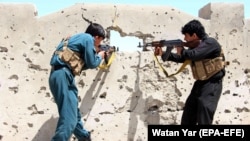LASHKAR GAH, Afghanistan -- A white unmarked Toyota pickup truck carries 10 armed young fighters to a frontline. All are dressed like Taliban fighters, with most wearing black or dark green khet partug -- a long loose tunic and baggy pants. All are wearing the distinctive black or white turbans preferred by the Taliban.
They, however, are not Taliban. As members of a secretive Afghan government militia, their mission on a cold February morning is to infiltrate groups of insurgent fighters along a tense frontline in the restive southern province of Helmand.
As they speed along a twisting rural road past fields, orchards, and clusters of mud houses, only one of them agrees to briefly talk.
He requests not to be identified by name because the Taliban are actively pursuing and targeting members of the force, which is locally called Sangorian.
“We are proud of what we are doing. We turn insurgent tactics against them and fight them in the same civilian dress they wear,” he told Radio Free Afghanistan. “My only regret is that we sometimes scare civilians because they mistake us for the insurgents.”
Sangorian, named after a Turkish television soap opera about undercover operatives, claims credit for defeating Taliban attempts to overrun Helmand’s capital, Lashkar Gah. The insurgents virtually besieged it for months in 2016.
Estimated to now number between 500 and 1,000 fighters, the militia was created alongside the Bost Unit by the Afghan secret service, the Directorate of National Security.
“We have always inflicted harm on the enemy. We have killed their fighters and captured their weapons and ammunition,” the Sangorian member said. “This is why the enemy is keen to retaliate. They often use heavy weapons to attack our units.”
The Taliban killed at least 16 Sangorian members in an attack on a check post in Helmand’s Gereshk town on February 10. “Three of our brothers turned their guns on militia members after infiltrating one of their important camps,” a Taliban statement said.
Communist-era former general turned lawmaker Abdul Jabbar Qahraman is all praise for Sangorian. As Afghan President Ashraf Ghani's operational commander for Afghan forces in Helmand two years ago, he reportedly oversaw the formation of Sangorian.
“They were so successful that our enemies began to fight among themselves,” he told Radio Free Afghanistan. “Their sabotage within the enemy ranks prompted many Taliban commanders to mistrust each other so much that they began to surround themselves with bodyguards to prevent possible attacks from rivals.”
After the drawdown of most international troops by the end of 2014, the Taliban scored major territorial gains in Helmand, Afghanistan’s largest province, strategically located near Iran and bordering Pakistan. By early 2016, the insurgents controlled or contested 12 of the region’s 14 districts and were threatening to overrun the entire province by besieging Lashkar Gah. The city of an estimated 300,000 residents is home to important government departments and major military encampments.
Qahraman says it was Sangorian’s operations behind insurgent lines in the strongholds of Sangin and Musa Qala districts that prevented the Taliban from overrunning the provincial capital.
“As a former army general, I can tell you confidently that they played a major role in preventing the fall of Lashkar Gah to the enemy,” he said.
Not everyone in Lashkar Gah, however, is happy about Sangorian’s success. Some residents whisper of alleged abuses by the militia -- claims the authorities reject, saying they have received no formal complaints of misconduct.
During nearly 40 years of war, Helmand’s residents have repeatedly seen government militias turn into marauding thugs. Civilians and politicians are now worried Sangorian will follow the same path.
Lawmaker Attaullah Afghan leads Helmand’s provincial council. He says that after performing their main task of preventing the fall of Lashkar Gah, Sangorian members no longer need to to work undercover.
“The people of Helmand now want Sangorian and other similar groups to wear the uniform of forces commanded by the Directorate of National Security,” he told Radio Free Afghanistan.
Omar Zhwak, the spokesman for Helmand’s governor, says the government is already working on such a plan.
“We are working on building them up in terms of education, discipline, and equipment to bring them on par with other forces,” he told Radio Free Afghanistan. “They have proved very useful.”
Abubakar Siddique wrote this story based on Radio Free Afghanistan correspondent Mohammad Ilyas Dayee's reporting from Lashkar Gah, Helmand.








